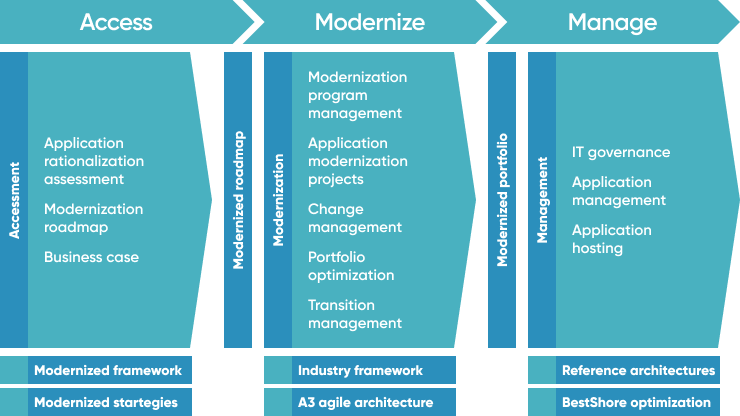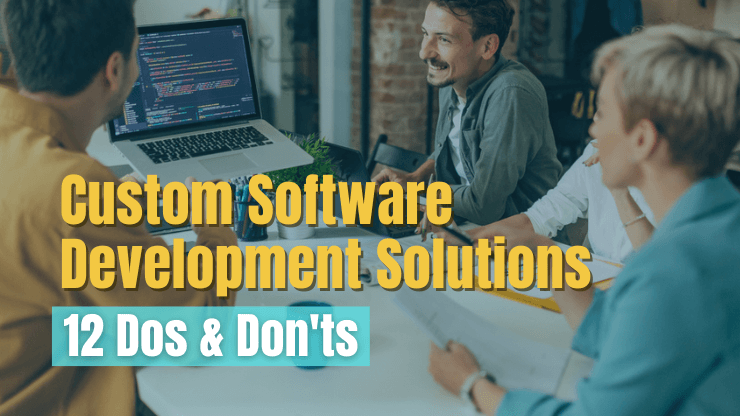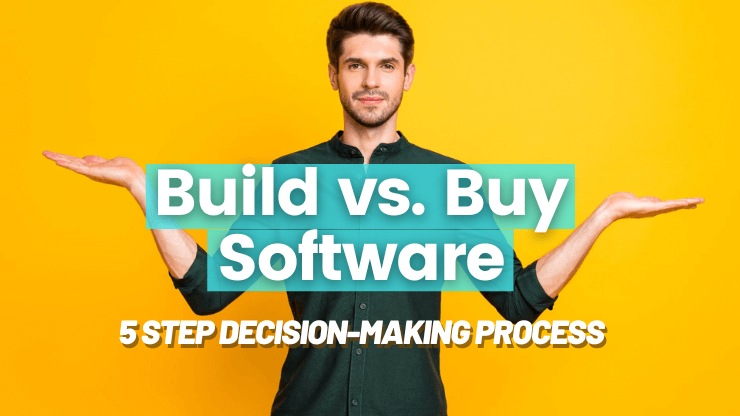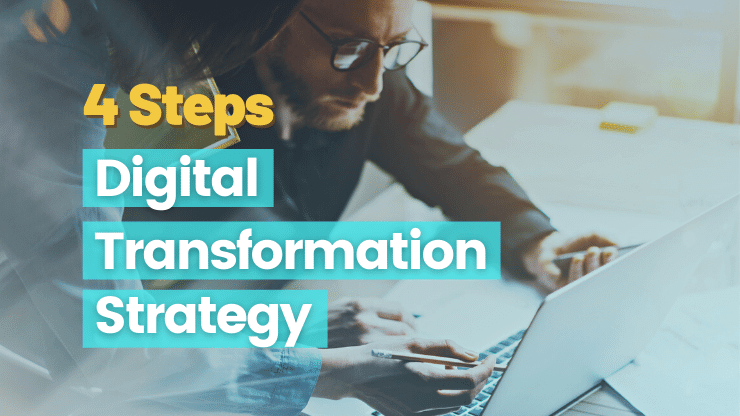Legacy IT systems often become a roadblock to innovation and efficiency. In fact, recent Forrester findings indicate that 70-90% of such systems will need modernization in the coming five years, spotlighting the urgency of this transformation.
In this guide we explore the compelling benefits of a comprehensive application modernization roadmap, and the practical steps for adopting the latest technologies in your organization. These resources will propel you towards a modernization strategy that will allow you to meet business demands today and long into the future.
What is application modernization?
At its core, application modernization is about bringing legacy applications up to speed with current and future business needs. Historically, many businesses operated on static, on-premises applications developed using the waterfall model. The modern shift emphasizes integrating these traditional applications into cloud environments and incorporating newer methodologies such as DevOps transformation and modular architectures, moving away from the classic monolithic designs.
While application modernization can manifest as one-off projects, more often, businesses will have a continuous app modernization roadmap to enhance their platform infrastructure, update internal architecture, and add new features on a more ongoing basis.
Modernization is typically driven by one of two things:
- Immediate business need - This might be in response to pressing issues like patching a critical security vulnerability after a breach, or managing escalating data storage costs.
- Strategic digital transformation - Here, the focus is on a forward-thinking enhancement of legacy apps. Of course, it will still address short-term needs, but it typically manifests as a more holistic approach to modernization.
What are the business benefits of an app modernization roadmap?
Embracing a strategic application modernization roadmap is pivotal for businesses aiming to thrive in today's dynamic digital landscape. It's more than just updating software; it's about maximizing efficiency, security, and adaptability to meet current and future business needs.
Business can benefit from a strong application modernization roadmap in a number of ways, including:
- Enhanced security - Modern applications integrate the latest security protocols, offering superior protection for both business operations and sensitive data.
- Maximized business value - Streamlined and updated applications drive operational efficiency and optimize ROI, directly contributing to business growth and value.
- Operational stability - Up-to-date architectures and technologies underpinning modernized applications bolster system reliability, reduce downtime, and offer a more consistent user experience.
- Data accessibility & insights - Modernized platforms provide more intuitive data access, facilitating informed decision-making and business agility.
- Strategic alignment & future-readiness - When you modernize legacy applications, you can ensure that your applications are attuned to long-term goals, while harnessing new technologies like AI, positioning them advantageously in the evolving market landscape.
3-Step Legacy Application Modernization Roadmap
With an understanding of the key drivers of a thorough application modernization roadmap, let’s turn to the practicalities of how your organization can begin to implement such a roadmap.
An effective app modernization roadmap serves as a strategic compass, guiding businesses in modernizing their older systems, making them more compatible with today's tech ecosystem, and ensuring they can harness the full potential of modern innovations. This roadmap is characterized by a structured and phased approach:

- Assess - The process begins by evaluating the legacy system's architecture and its alignment with current business objectives. This application assessment will help to identify areas for improvement and ensure your team can set strategic goals for modernizing applications.
- Modernize - Whether it's re-platforming, re-architecting, or a complete overhaul, this is where the actual modernization work begins. The project team will use the strategy designed during the assessment stage to modernize the legacy apps.
- Manage - Application modernization continues with a strategic approach to managing the newly updated applications. This will involve continuously monitoring and updating the applications for optimal performance and alignment with evolving business priorities.
In this section we’re going to break each of these three step down and provide practical advice for your own legacy application modernization project. Let’s get started!
Assess

Modernizing legacy applications begins with a thorough assessment phase. This stage provides a holistic understanding of the current state of the legacy application and helps teams identify critical areas that need modernization. With a comprehensive assessment, organizations can create a business case that clearly defines the necessity and objectives of the modernization initiative.
What are the expected business outcomes during this step:
- A clear roadmap for modernizing core business applications, which outlines the anticipated benefits, potential risks, and dependencies. This could also include the critical processes that will be affected by the modernization approach.
- A blueprint for the target state of a modernized application, which includes the technical and functional architecture. This blueprint should also have a proof of concept to demonstrate the viability of the app modernization strategy.
- An action plan to address identified gaps, enabling the organization to proceed with the modernization project without unforeseen hindrances. This should include identified project management software, tools, and processes to effectively manage the project.
Who are the key stakeholders during this step:
- Strategic planners - Define and align the application modernization roadmap with the long-term business strategy.
- Technical auditors - Evaluate existing systems to identify strengths and areas for improvement that could be addressed as part of the application modernization roadmap.
- Business analysts - Translate business needs into technical requirements and desired functionalities.
- End-users - Offer first-hand feedback about the current application's usability and areas for enhancement.
What activities should be completed during this step:
1. Define the business case for modernization
Legacy application modernization efforts should always stem from a well-documented business case. This will help to orient all stakeholders on the purpose of the project and ensure they remain focused on it throughout the project’s lifecycle. In most enterprises, this will break down into two areas:
- The business side - Concerned with business process support, business value, and scalability. If a legacy application is no longer meeting existing or new requirements from the business, a modernization strategy should be considered. Furthermore, if the legacy application is not scalable or flexible enough to help the business achieve its goals over the next few years, an application modernization project or broader digital transformation strategy should be considered.
- The IT & engineering side - Concerned with cost, risks, complexity, and support. A business case for modernization can also stem, in part, from the IT or engineering side. If legacy systems are costly to maintain, complex to support, or open up the business to security or compliance risks, it’s time to consider legacy application modernization.
2. Assess the legacy application
After a clear business case has been defined, the team should zoom out and review the existing systems more holistically. This should involve an assessment of the following:
- Strategic or business fit - Review how the legacy application aligns with current business objectives and goals. This includes examining how many users actively use the software, the total usage time, and common usage pathways. It's essential to map out the business processes the software supports, ensuring any future upgrades or replacements will serve the evolving business needs effectively.
- Usability and features - Examine the functional features of the legacy application and whether they are meeting the present requirements of the users. Are there redundant or missing functionalities? A gap analysis might be helpful here.
- Integrations - Evaluate how well the software interacts with other systems, both internal and external. Identify if these integrations are meeting current business needs or if they've become outdated or cumbersome.
- Technical adequacy - Scrutinize the stability and health of the infrastructure that supports the legacy application. This could involve checking system uptimes, crash reports, or other technical metrics. Identify any areas where 'quick fixes' or outdated technologies were used, potentially jeopardizing the system's stability or security.
- Spend - Look across the organization to determine overall spend on the legacy system in areas such as software licensing, maintenance, 3rd party integrations, and technical support.
- Future proofing - Determine how ready the system is for modern digital transformation. Can it easily integrate with newer technologies or platforms? Is it scalable to accommodate future business growth or changes?
- Risks - Conduct a thorough risk assessment of maintaining the legacy application as well as the risks associated with disrupting the business during modernization. These risks should be carefully weighed before proceeding.
3. Conduct a SWOT analysis
After you’ve thoroughly assessed your legacy applications, you should look at this information through the lens of your business case. This will help you to see areas of improvement that need to be prioritized over others.
Not every concern or issue will be able to be addressed when creating an application modernization roadmap, but you may have identified areas during the assessment process above that you otherwise may not have. This is the time to weigh all of these concerns against each other.

- Strengths - In what ways is the legacy system functioning well? What do users like about the software? How is the software aiding in streamlining workflows or processes? How is the application meeting budget goals?
- Weaknesses - In what ways is the legacy system creating friction or slowing down processes? Has the system been end-of-lifed or no longer supported by the vendor? Are there data continuity issues?
- Opportunities - Could efficiency be improved? Are there opportunities for better integrations with other software in the tech stack? Could manual processes be replaced with automated ones? Can the user experience be improved?
- Threats - What security or compliance threats is the legacy software opening you up to? Is the legacy system a threat to staying competitive as an employer or business?
4. Choose a modernization strategy
You will find as you prioritize areas of improvement that an application modernization strategy may begin to formulate naturally. Maybe it becomes clear that the project scope will be quite broad - encompassing many interconnected systems that need to be lifted and shifted into the cloud. Or maybe to reduce costs and minimize risks, it seems plausible to scale back your modernization plan and focus on rearchitecting one core component of your tech stack.
However, if a clear modernization plan is not obvious, consider looking at the information through the lens of this matrix. This process can help to guide towards a particular modernization approach.

Keep in mind that there are many application modernization strategies to consider. The goal is to choose an approach that is most aligned to your business and technical needs and that can be achieved within your budget. Legacy app modernization strategies to consider include:
- Encapsulate. This strategy focuses on extending the legacy systems’ current features by making them available as services with an API.
- Rehost. With this strategy, there are no changes to the code, features or functions. Instead, the focus is on deploying the application’s components onto more modern infrastructure such as into a cloud environment.
- Replatform. This strategy involves minimal code changes without any changes to the code structure, features or functions. The application would be migrated to a new runtime platform.
- Refactor. With this strategy the focus is on removing technical debt and improving non-functional attributes by restructuring and optimizing the existing code.
- Rearchitect. With this strategy, there is a clear focus on altering the code to make it work more effectively within a new application architecture. There might also be significant changes to the functionality along with the use of new technologies.
- Rebuild. Not to be confused with replacing, this strategy involves keeping the original scope of the legacy application while redesigning and/or rewriting the application components from the ground up.
- Replace. In our final strategy, the application is fully replaced with an altogether new and different application that is built using new requirements.
PRO TIP: Be aware of the reasons why many legacy modernization projects fail. Being aware of these pitfalls will help you to set realistic expectations and proactively address them during the assessment and planning stages of your application modernization projects.
Drawing inspiration from a study by researchers at Carnegie Mellon here are 10 reasons why legacy re-engineering efforts fail that you should be aware of:
- The organization adopts a flawed strategy from the start.
- The organization relies too heavily on outside consultants.
- The team is tied down to old technologies and inadequate training.
- The organization thinks it has its legacy system under control (it doesn't).
- The needs of the organization are oversimplified.
- The overall software architecture isn't given enough consideration.
- There is no defined application modernization process.
- Inadequate planning and follow through.
- Lack of long-term commitment to the strategy.
- Leaders pre-determine technical decisions.
Modernize

Having rigorously assessed the state and challenges of your legacy systems, the next logical step is modernization itself. This isn’t merely a technical endeavor; it's a transformative journey that holistically integrates technology, processes, and people.
What are the expected business outcomes during this step:
- Implementation of an application modernization roadmap based on the objectives and goals developed during the assessment stage.
- Phase out old components and integration of advanced ones aligning with organizational objectives.
- Deployment of the new application into a production environment.
- Thorough testing, from code baseline checks to user acceptance tests.
Who are the key stakeholders during this step:
- Project managers - Oversee the modernization process, ensuring alignment with set goals and timely execution.
- Technical architects - Design the system's improvements or overhaul, selecting appropriate technologies and frameworks.
- Quality assurance teams - Test the new system rigorously, ensuring it meets quality and performance standards.
- Infrastructure specialists - Ensure the modernized system's resilience, addressing hardware or cloud requirements.
What activities should be completed during this step:
1. Develop a detailed project plan
At the heart of a successful application modernization effort is a well-thought-out project plan. This plan is the culmination of understanding the application landscape, its intricacies, and the benefits, risks, and costs of change. A solid project plan and app modernization roadmap will include:
- Software development approach - Embrace an agile methodology to dissect the project into manageable units.
- Clear milestones - Detail out the development sprints and associated milestones. Two-week sprints are often recommended for agility.
- Dependencies - Highlight potential dependencies that might influence the development and deployment phases.
- Budget and resourcing - Allocate resources, both internal and external, for software development, project management, and testing.
2. Replace outdated components & implement new ones
Modernizing legacy applications is a careful balance between phasing out antiquated elements and integrating advanced components. It starts with an in-depth understanding of the application landscape, preparing for a smooth transition to modern platforms that enhances value delivery without disrupting business continuity.
As the app modernization process unfolds, it becomes imperative to address outdated components, gradually replacing them while simultaneously integrating newer, more efficient parts. This strategic evolution ensures applications are not only current but also optimized for scalability and performance. Key tips for successful modernization:
- Utilize a phased approach, prioritizing the updating or removal of legacy components based on their criticality and complexity.
- Opt for reliable technologies and platforms, like Django or AWS Quicksight, that align best with the organization's objectives and future goals.
- Ensure a robust, cloud-native infrastructure that emphasizes reliability, accessibility, and growth, utilizing the finest languages and frameworks available.
3. Perform application testing and validation
Once the new components are in place, rigorous testing ensures the system works seamlessly:
- Code testing - The development team should conduct baseline code testing on all new and modified components to ensure it executes as expected.
- Data integrity testing - This is really critical for enterprise systems where there may be “dark data” being stored in places unknown to the organization. It’s imperative that data integrity is checked for all business processes to ensure data hasn’t been lost.
- User acceptance testing - UAT should be conducted with all user groups to ensure the new software system meets expectations and is working as expected.
It's vital to address any issues that arise during this phase promptly, ensuring a polished final product ready for deployment.
4. Deploy the modernized application
The culmination of the modernization process is the deployment of the updated application. This isn't merely about launching the application; it involves ensuring its seamless integration within your existing tech ecosystem.
To elevate the success of this deployment, it's pivotal to embrace a DevOps mindset, focusing on continuous, incremental improvements. Additionally, a phased deployment strategy can be instrumental in risk mitigation and in procuring early, valuable feedback.
Manage

After deploying modernized software, the journey doesn't end. The management phase is where an enterprise ensures that the newly-implemented system delivers the expected value, meets business objectives, and integrates seamlessly into the overarching IT environment.
This phase involves close monitoring, governance, and continuous feedback loops to ascertain that the modernized application not only works as intended but also evolves with the changing needs of the organization.
What are the expected business outcomes during this step
- Enhanced productivity and efficiency from the new system.
- Achieving stated business goals, which formed the foundation of the modernization effort.
- Improved agility and flexibility of the application.
- Cost-effective operation with minimized risks.
- Positive user reception and feedback.
Who are the key stakeholders during this step
- Application manager/application analyst: Responsible for overall application lifecycle management, skills gap analysis, and resource acquisition.
- Business unit owners: Evaluate applications in terms of bottom-line benefits and impact on revenue.
- Developers/DevOps/DevSecOps: Handle design, deployment, security, and ongoing maintenance.
- Application users: Their feedback is critical to gauge application performance, privacy, and security.
What activities should be completed during this step
1. Complete “housekeeping” tasks
Like any software development or IT project, there is work to be done after a project has launched to ensure it can successfully transition into full production.
- Purge outdated data: Identify and eradicate outdated or unnecessary data post-deployment to free up valuable storage space and maintain data integrity.
- Update documentation: Reflect the modernized system by ensuring all relevant user guides, system architecture diagrams, and operation manuals are current and accurate.
- Manage software licenses: Adjust or renew licenses as needed based on the new setup, ensuring all software licenses are in compliance with legal requirements.
2. Evaluate the success of the modernization work
Understanding whether the modernization effort hit the mark is crucial. From the IT team to the end-users, collecting feedback provides a holistic view of how the modernized system is performing. This feedback can be gathered through structured surveys, one-on-one interviews, or focus group discussions.
Consider questions such as:
- Did the modernization effort help to achieve stated business goals?
- How has productivity or efficiency improved since deployment?
- Is the new application more agile and flexible?
- Were costs and risks successfully managed?
- How are users responding to the new application?
- Is there anything left undeveloped or goals left unmet?
In conjunction with qualitative feedback, validate the success of your modernization work by gathering quantitative data and comparing it against the KPIs.
3. Adjust and refine the modernization strategy
Post-evaluation, take a step back and review the overall modernization strategy. Are the initial objectives still aligned with the current business needs and the results obtained?
If the modernization proved successful, consider employing the learned best practices for other potential legacy system upgrades.
However, if certain challenges arose, it's essential to treat them as learning opportunities to adjust and fine-tune the roadmap for future projects. This iterative approach ensures that with each project, the organization becomes more adept at handling modernization efforts.
SoftKraft - Let us help you modernize your legacy applications
| Lift & Shift Seamlessly transition your application to the cloud with our streamlined approach, ensuring immediate scalability and flexibility while minimizing disruptions and code alterations. | Augment & Migrate We streamline your application for the cloud by making essential adjustments to its code and configuration, all while maintaining its external functionality and preserving its original architecture. |
| Performance Enhancement We focus on pinpointing and rectifying bottlenecks, outdated code, and scalability issues to improve software performance and ensure that your application remains agile and responsive to evolving business demands. | Full-Stack Reengineering If your software stack has aged beyond simple tweaks, we'll work you to build a future-forward, fully modern solution designed to drive your business today and adapt seamlessly for tomorrow. |
Why choose our legacy application modernization services
- Experience tailor-made modernization with our bespoke, user-focused approach.
- Elevate both user experience and software performance simultaneously with our multifaceted modernization team.
- Embrace cutting-edge technologies, including Machine Learning, AI, and Big Data, to stay ahead.
- Launch new features faster than ever - Our cloud engineers and designers have years of experience in bringing systems up to date quickly







